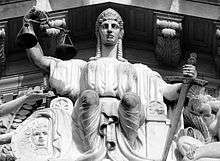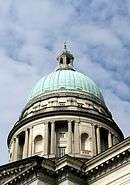Prime Minister of Singapore
The Prime Minister of the Republic of Singapore is the head of the government of the Republic of Singapore, and the country's most powerful political figure. The President of Singapore appoints as Prime Minister a Member of Parliament (MP) who, in his or her opinion, is most likely to command the confidence of a majority of MPs. In practice, the Prime Minister is usually the leader of the majority party in the legislature.
| Prime Minister of the Republic of Singapore | |
|---|---|
 Prime Minister's Crest | |
| Style | The Honourable |
| Residence | Sri Temasek |
| Appointer | President of the Republic of Singapore |
| Term length | 5 years or earlier, renewable. The Parliament of Singapore must be dissolved every 5 years or earlier by the Prime Minister. The leader of the majority party will become the Prime Minister. |
| Inaugural holder | Lee Kuan Yew |
| Formation | 3 June 1959 |
| Salary | S$2.2 million per annum |
| Website | www |
| Prime Minister of the Republic of Singapore | |||||||
|---|---|---|---|---|---|---|---|
| Chinese name | |||||||
| Traditional Chinese | 新加坡共和國總理 | ||||||
| Simplified Chinese | 新加坡共和国总理 | ||||||
| |||||||
| Malay name | |||||||
| Malay | Perdana Menteri Republik Singapura | ||||||
| Tamil name | |||||||
| Tamil | பிரதமர் சிங்கப்பூர் குடியரசு piratamar Ciṅkappūr kuṭiyaracu | ||||||
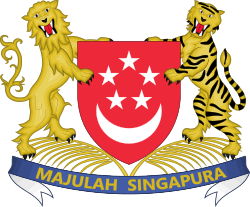 |
|---|
| This article is part of a series on the politics and government of Singapore |
|
|
|
Related topics |
|
|
Under the Constitution of Singapore, executive power is vested in the President. However, the Constitution also vests "general direction and control of the government" in the Cabinet. The President is almost always bound to act on the advice of the Cabinet or any minister acting under Cabinet authority. Thus, in practice, most of the actual work of governing is done by the Prime Minister and Cabinet.
The office of Prime Minister dates back to 1959 and was appointed at first by the Governor of Singapore then the Yang di-Pertuan Negara (vice-regal head of state), when Singapore achieved self-governance as the State of Singapore within the British Empire. The title of Prime Minister remained unchanged after the merger with the Federation of Malaya, Sarawak and North Borneo, while Singapore was a state in the Federation of Malaysia from 1963 to 1965, and after independence in 1965.
The late Lee Kuan Yew was the first prime minister of Singapore from 1959 to 1990. Lee was succeeded by Goh Chok Tong and was conferred the title of Senior Minister in the Prime Minister's Office. Goh Chok Tong retired on 12 August 2004 and was succeeded by Lee Kuan Yew's son Lee Hsien Loong. Goh Chok Tong was appointed Senior Minister, and the elder Lee Minister Mentor. Lee and Goh resigned from the Cabinet in 2011 but remained as members of Parliament. The only former living prime minister is Goh Chok Tong who served in 1990. [1]
The Prime Minister's annual salary was S$3.07 million before a salary review in 2011.[2] On 21 May 2011, a committee was appointed by the Prime Minister to review the salaries of the Prime Minister as well as the President, political appointment holders, and Members of Parliament.[3] After the recommended wage reductions by the committee were accepted in Parliament, the Prime Minister's salary was reduced by 36% (including the removal of his pension) to S$2.2 million (approximately US$1.7 million at the time).[2]
Nonetheless, the Prime Minister remains the highest-paid political leader in the world.[4]
List of Prime Ministers of Singapore
| Portrait | Name (birth and death) Constituency |
Term of office | Party | Time in office | |||
|---|---|---|---|---|---|---|---|
| 1 | 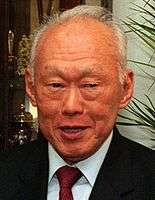 |
Lee Kuan Yew 李光耀 லீ குவான் இயூ (1923–2015) MP for Tanjong Pagar GRC, 1955–2015 |
5 June 1959 | 28 November 1990 | 31 years, 178 days | ||
| 1959, 1963, 1968, 1972, 1976, 1980, 1984, 1988 | |||||||
| The first Prime Minister of Singapore and the youngest to be elected in the office, at the age of 35. He is the longest-serving Prime Minister of Singapore. His tenure led to the expansion of Singapore's economy from a British Crown Colony into a first world country. He introduced the National Service (NS) scheme, with the help of his Defence Minister Goh Keng Swee. He introduced the Stop-At-Two child policy in 1960s, for fearing of over expansion of Singapore population. In the 1980s, he introduced the Graduate Mother Scheme to counter the effects of the previous policy, which received a huge backlash. The policy was withdrawn shortly thereafter. He led the PAP into 8 consecutive election victories. During his tenure, Singapore grew to become the most prosperous nation in South-east Asia.[5] | |||||||
| 2 | 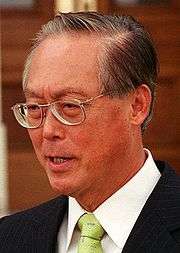 |
Goh Chok Tong 吴作栋 கோ சொக் தொங் (b. 1941) MP for Marine Parade GRC, 1988–2020 |
28 November 1990 | 12 August 2004 | 13 years, 258 days | ||
| 1991, 1997, 2001 | |||||||
| The second Prime Minister of Singapore. He introduced several major policies and policy institutions, such as Medisave, Non-constituency Members of Parliament, Government Parliamentary Committees, Group Representation Constituencies, Nominated Members of Parliament, the Vehicle Quota Scheme, the direct election of the President and Singapore 21. During his tenure Singapore experienced several crises, such as the 1997 Asian financial crisis, threats of terrorism including the 2001 Singapore embassies attack plot by Jemaah Islamiyah, the 2001–2003 economic recession, and the 2003 SARS outbreak. He also introduced the Baby Bonus scheme in a bid to increase birth rates. Prior his appointment as PM, he served as Senior Minister of State for Finance, Minister for Trade and Industry, Minister for Health, Minister for Defence and first Deputy Prime Minister.[6] | |||||||
| 3 | Lee Hsien Loong 李显龙 லீ சியன் லூங் (b. 1952) MP for Ang Mo Kio GRC, 1991–present |
12 August 2004 | Incumbent | 15 years, 320 days | |||
| 2006, 2011, 2015 | |||||||
| The third Prime Minister of Singapore. He introduced the five-day working week for civil servants, with the hope of increasing the birth rate. One of his major accomplishments was to propose the building of 2 Integrated Resorts (IR) in Singapore. Singapore hosted the inaugural summer Youth Olympic Games in 2010. He promoted the abolition of school ranking. In 2013, he presided over the worst haze crisis and worst Dengue epidemic in Singapore. He also presided during the COVID-19 pandemic. Prior to his appointment as PM, he served as Deputy Prime Minister (1991–2004), Minister of Finance, Minister of Trade and Industry. | |||||||
See also
References
- Singapore, National Library Board. "Past and present leaders of Singapore | Infopedia". eresources.nlb.gov.sg. Retrieved 22 September 2018.
- "White Paper - Salaries for a Capable and Committed Government". Public Service Division. 10 January 2012. Archived from the original (PDF) on 7 May 2015. Retrieved 15 April 2020.
- "Committee to review salaries of the President, Prime Minister and Political Appointment Holders" (Press release). Prime Minister's Office. 22 May 2011. Archived from the original on 5 March 2016. Retrieved 15 April 2020.
- Mathew, Jerin (28 March 2015). "Singapore PM Lee Hsien Loong remains highest paid country leader with $1.7m annual salary". International Business Times. Retrieved 15 April 2020.
- "Lee Kuan Yew | prime minister of Singapore". Encyclopedia Britannica. Retrieved 22 September 2018.
- "Impressions of the Goh Chok Tong Years in Singapore". NUS Press. Retrieved 22 September 2018.
External links
| Wikimedia Commons has media related to Prime ministers of Singapore. |
